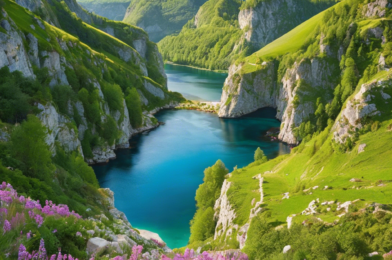UNESCO World Heritage Sites are known for their exceptional cultural, historical, or scientific significance, but some of these sites remain lesser-known gems that are just waiting to be discovered. Offering a glimpse into the hidden corners of our planet’s rich history, these sites are sure to spark wonder and curiosity. From ancient ruins that hold secrets of civilizations long gone to natural wonders that showcase the Earth’s breathtaking beauty, each of these places tells a unique story and is worth exploring. Imagine standing in a place where history comes alive, where the echoes of the past blend with the vibrant cultures of today, offering a profound understanding of our shared human legacy. Prepare to be amazed as we explore some of these incredible sites, offering a window into the diverse and fascinating history of our world.
One such site is the Ancient Nara, a city in Japan that served as the country’s first capital. Founded in 710 AD, Nara is home to a wealth of historic treasures, including Buddhist temples and shrines, as well as the magnificent Kasugaya Hill Primeval Forest. This site showcases the harmonious blend of religious architecture and natural beauty that has influenced Japanese culture for centuries. Walking through the ancient streets of Nara, one can almost hear the echoes of the past, a whispered reminder of the city’s former glory and its enduring legacy.
Another remarkable UNESCO site is the Historic Center of Shakhrisyabz in Uzbekistan. This ancient city, once known as Kesh, was a key trading post along the Silk Road. Founded over 2,700 years ago, Shakhrisyabz boasts well-preserved monuments that showcase the unique blend of medieval Central Asian architectural styles. The majestic Ak-Saray Palace, with its towering gates and intricate tile work, stands as a testament to the city’s golden age under the rule of Amir Temur in the 14th century.
Step back in time as you explore the Ancient City of Nessebar, Bulgaria, a UNESCO site that is nothing short of enchanting. With roots dating back to the 6th century BC, this coastal town is a treasure trove of archaeological wonders. Meandering through the cobblestone streets, you’ll discover ancient churches, charming wooden houses, and remnants of the fortified walls that once protected the city. Nessebar’s rich historical tapestry reflects the influence of the Thracians, Greeks, Romans, and Byzantines, offering a glimpse into the vibrant cultural exchange that shaped this region.
The Sundarbans National Park in India, where breathtaking natural beauty meets a vibrant cultural heritage, is another UNESCO site. This vast mangrove forest, spread across India and Bangladesh, is a biodiversity hotspot teeming with unique flora and fauna. Beyond its ecological significance, the Sundarbans is deeply intertwined with the local communities who call it home. The park is a source of inspiration for art, music, and folklore, reflecting the deep spiritual connection between nature and humanity.
In a remote region of northern Kenya lies another hidden UNESCO gem: the Lake Turkana National Parks, a series of three interconnected parks that showcase the breathtaking beauty of this arid landscape. Known as the “Cradle of Mankind,” this site has revealed crucial fossil evidence of our human evolutionary history. The starkly beautiful terrain, with its volcanic hills and shimmering lakes, is also home to a diverse array of wildlife, including rare species like the Grevy’s zebra and the reticulated giraffe.
Deep in the heart of the Amazon rainforest lies another UNESCO site, the Historic Town of Ouro Preto in Brazil. This charming colonial-era town, founded in the late 17th century, is a living museum of Brazilian history. The well-preserved architecture, with its elegant churches and colorful colonial homes, stands as a testament to the town’s rich cultural heritage. Ouro Preto’s cobblestone streets echo the footsteps of a bygone era, inviting visitors to embark on a journey through time.
Embark on a journey to the ancient Kingdom of Aksum in Ethiopia, a UNESCO site that holds profound religious and historical significance. Once a powerful trading empire, Aksum flourished between the 1st and 8th centuries AD. Today, visitors can explore the mysterious stelae, towering obelisks that stand as silent sentinels to the past, as well as ancient tombs and castles that bear witness to a glorious era. The Kingdom of Aksum is not just a physical place, but a spiritual one, deeply intertwined with the roots of Christianity in Africa.
Discover the awe-inspiring beauty of the Trulli of Alberobello, a UNESCO site located in the picturesque Puglia region of Italy. These unique, conical-roofed dwellings, known as trulli, dot the rolling hills and create a landscape like no other. Built using locally sourced limestone, the trulli were constructed without mortar, showcasing the ingenuity and resilience of rural communities. Stepping into Alberobello is like entering a fairy tale, where each trullo tells a story of simpler times and strong community bonds.
Experience the majesty of the Lake District National Park in the United Kingdom, a UNESCO site that has captured the hearts and imaginations of poets, writers, and artists for centuries. This breathtaking landscape of glittering lakes, towering mountains, and lush valleys has inspired creative geniuses such as William Wordsworth and Beatrix Potter. Beyond its natural beauty, the Lake District is a testament to the enduring relationship between humans and the natural world, as centuries of agricultural and pastoral activities have shaped the landscape we cherish today.
Lastly, let’s explore the stunningly beautiful and culturally rich Hahoe and Yangdong villages in the Republic of Korea. These secluded clusters of historic houses, set amidst serene natural landscapes, embody the unique Confucian culture and traditions of ancient Korean aristocratic clans. The thatched roofs, elegant wooden architecture, and harmonious integration into the surrounding environment reflect the profound respect for nature and ancestral traditions that have endured for centuries.






